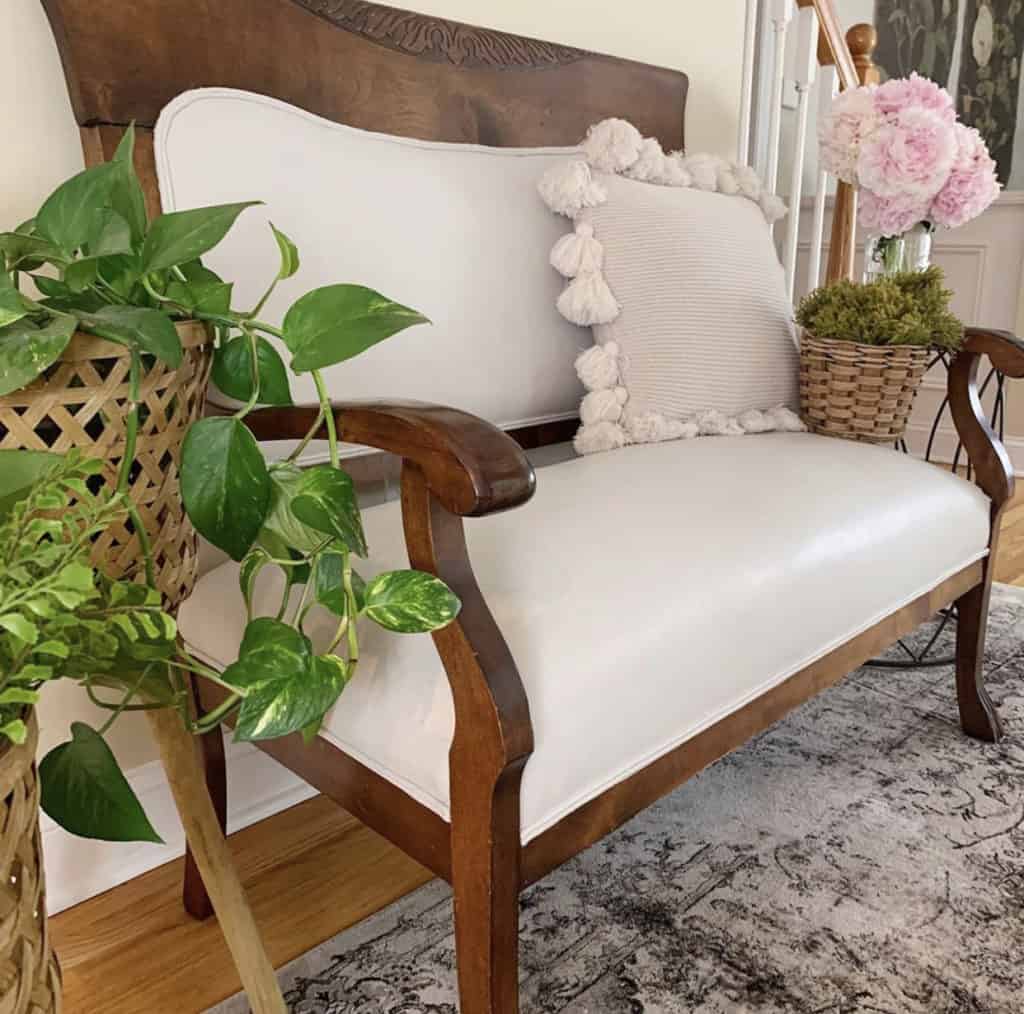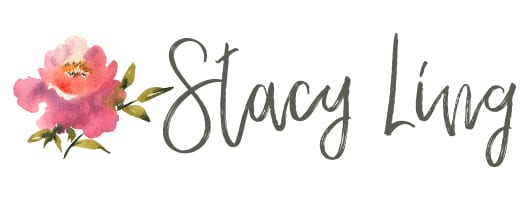Discover everything you need to know about painting upholstery with chalk paint in this comprehensive FAQ. Get expert tips, understand the process, and find answers to common questions about durability, texture, and tools.
Painting upholstery with chalk paint can be a game-changer for your home decor projects, offering a unique and stylish look without the need for extensive prep work.
In this article, we’ll tackle the most frequently asked questions about using chalk paint on fabric, from its durability to application techniques.
Whether you’re a seasoned DIY enthusiast or a beginner looking to revamp your furniture, our expert tips and insights will help you achieve stunning results with ease. Dive in to learn everything you need to know about this easy, creative painting method.
(Posts on stacyling.com may contain affiliate links. Click HERE for full disclosure.)

Frequently Asked Questions and Answers About Chalk Painting Upholstery Fabric
I learned how to chalk paint fabric a few years ago when I remodeled our entryway and decided to update a family heirloom bench. The result is amazing and our antique bench has held up really well.
You guys really love that project. So do I.
But I also loved painting upholstered furniture with chalk paint on THIS chair and THIS chair.Since doing all these projects, I’ve have had so many questions about applying chalk paint on fabric and the process.
Thank you so much for all of your interest and comments about painting upholstery fabric!
I’ve also received some emails with several questions how my fabric upholstery is holding up. Chalk paint is one of my favorite paints to work with because it’s super simple to use, easy to buy or make, and has helped me transform my home.
So let’s talk about how to chalk paint upholstery fabric with some FAQ.
I’m answering questions (if you have any questions about specific things in the house you can find them here) and giving advice with a little confidence-building thrown in there too.

What is Chalk Paint?
To be technical, chalk paint is a registered trademark of the Annie Sloan brand. However, there are lots of other companies that also make chalk-style paint. There are also DIY recipes if you want to make your own chalk-style paint.
Chalk paint can be used in a variety of ways. It can be applied as a solid color. Or to create a vintage look, sand it down to wear the edges.
I love working with chalk paint because it’s easy to use, cleans up well, and looks great with any home decor.
When chalk paint dries, many DIYers topcoat with wax to seal and protect the color. However, there are some instances where polyurethane or polycrylic can be used instead.
Where painting upholstery fabric is concerned, I seal each project with a clear wax.
What is the Difference between Chalk Paint and Regular Paint?
Regular paint is different from chalk paint in many ways.
- With chalk paint, pre-sanding is not necessary. You can paint over most clean and dry surfaces.
- Chalk paint distresses more easily than regular for an aged, vintage look.
- It also has a thicker consistency that makes it a little less messy to work with than regular paint while covering rough surfaces more smoothly.
- And since it is water-based, chalk paint is SUPER EASY to clean.

How to Use Chalk Paint
I love how chalk paint has a matte look when finished. And the best part?
It can totally update a piece without needing to strip or sand it down first. I don’t know about you, but that’s a major plus for me!
While chalk paint can be used on different types of surfaces without pre-sanding, I usually lightly sand most pieces that have rough spots or to smooth out the finish before painting.
If painting fabric, it’s important to lightly dampen the fabric before applying chalk paint so it soaks into the fabric better.
But regardless of whether you pre-sand or not, always clean each piece well before applying chalk paint to remove dirt and grease so the paint adheres better.
And if a surface is pre-sanded, wipe it down with a damp cloth to remove all the dust before painting.
In general, chalk paint typically covers in 1-2 coats of paint. When working with fabric, however, it covers in roughly 2-3 coats. That said, it all really depends on the look you want to achieve. You’ll know how many coats are needed while you work.


Can I Use Chalk Paint on Upholstery?
The answer is YES! You can chalk paint upholstery. Fabric is super easy to paint with chalk paint. And it works really well on upholstery fabric, cotton, linen, and velvet.
From my experience, I found that textured fabrics tend to finish a little rougher than smoother fabrics.
So you’ll want to lightly sand textured fabric down between coats before sealing.


How Well Does Chalk Paint on Upholstery Hold Up?
I recommend using low to mid-traffic pieces when painting upholstery fabric. The pieces I refinished held up really well, but they are not high traffic furniture pieces. They are more like occasional or rarely used pieces.
How Does Chalk Painted Upholstery Fabric Feel?
Painted upholstery fabric feels smooth and a little like tough leather. So it won’t feel as soft as it did before painting it.
As mentioned before, if you apply chalk paint on fabric that is textured, lightly sand it down to get it as smooth as possible between coats.
How Can I Make Fabric Paint Not Be Stiff?
Use a fabric medium to help the paint absorb better into the fabric. I like to mix a 3:1 ratio of chalk paint with fabric medium.
And it’s also a good idea to dampen the fabric with some water before applying chalk paint. This helps the paint soak into the fabric better.

Do You Have to Seal Chalk Paint?
Yes. It is very important to seal chalk paint with a wax or poly topcoat. Choosing which is better is a matter of preference and depends on the project.
For most projects, I prefer wax because it protects the color and looks better in my opinion.
When painting upholstery or other types of fabrics, wax is best to seal the paint and protect the color.

What Kind of Brushes Should I Use to Apply Chalk Paint to Upholstery?
Choosing what paintbrush you use is a matter of preference. Some prefer the round brushes, while others prefer regular paint brushes like this one.
In general, I grab whatever is handy.
For larger projects, I like using a larger brush to cover more area. And if I need to get into smaller crevices, I’ll grab a smaller craft-size paintbrush.

Where Can I Buy Chalk Paint?
If you want to buy official chalk paint, Annie Sloan is the only source. But there are several other brand options out there that make similar products. For example, Home Depot sells a variety of products by Behr and Rust-Oleum
Chalk-style paint products can also be found at most craft supply stores like Michael’s. Amazon also sells chalky-style paints.
It’s pretty easy to find sources of chalk-style paint. And if you don’t want to buy? You can make your own using this recipe.
Can I use chalk paint on different types of upholstery fabrics?
Yes, chalk paint can be used on a variety of upholstery fabrics, including cotton, linen, and synthetic blends. However, the texture and absorption rate may vary depending on the fabric type. It’s best to test a small, inconspicuous area first to see how the fabric reacts to the paint.
How do I prepare the upholstery before painting?
Preparation is key for a successful project. Start by thoroughly cleaning the upholstery to remove any dirt or oils. Use a vacuum to get rid of dust and debris. If the fabric is particularly dirty, consider using a fabric cleaner. Ensure the upholstery is completely dry before beginning to paint.
What tools do I need to paint upholstery with chalk paint?
To paint upholstery with chalk paint, you’ll need the following tools: chalk paint, a spray bottle filled with water, a paintbrush or foam brush, painter’s tape to protect non-painted areas, and a soft cloth for cleaning up any spills. Optional tools include a small roller for larger surfaces and a sealant if you want added durability.
How many coats of chalk paint should I apply?
The number of coats needed can vary depending on the fabric and desired coverage. Generally, two to three thin coats are recommended. Allow each coat to dry completely before applying the next one. Thinning the paint with a little water can help achieve a smoother finish.

Do I need to seal the chalk paint on upholstery?
Sealing chalk paint on upholstery isn’t always necessary, but it can add durability and protect the paint from wear and tear. Use a clear wax or fabric sealant, applying it in thin, even layers. Be sure to follow the manufacturer’s instructions for the best results.
How do I care for and clean painted upholstery?
To maintain your painted upholstery, avoid harsh cleaning agents. Instead, use a damp cloth to wipe down the surface. For tougher stains, a mild soap solution can be used, but test it on a small area first. Regular vacuuming can help keep the upholstery looking fresh.
Can I change the color of the upholstery if I don’t like the initial result?
Yes, you can repaint the upholstery if you’re not satisfied with the initial color. Simply apply additional coats of chalk paint in your new chosen color. Ensure the previous layer is completely dry and lightly sanded, if necessary, to promote better adhesion.
Are there any safety considerations when using chalk paint on upholstery?
When painting indoors, ensure proper ventilation by opening windows or using fans to circulate air. Wear a mask to avoid inhaling paint particles and consider using gloves to protect your skin. Always follow the safety instructions provided by the chalk paint manufacturer.

Final Thoughts on Painting Fabric With Chalk Paint
Painting upholstery with chalk paint is a creative and cost-effective way to breathe new life into your furniture. With the right preparation and techniques, you can achieve beautiful, durable results. Whether you’re a DIY novice or a seasoned pro, the tips and FAQs provided in this guide will help you navigate the process with confidence.
Ready to transform your furniture? Start your chalk paint project today and share your results with us! For more DIY tips and inspiration, subscribe to my newsletter and follow me on social media. If you have any questions or need further guidance, feel free to leave a comment below or reach out directly.
Happy painting!

Thank you so much for following along.
Enjoy a beautiful day! xo







